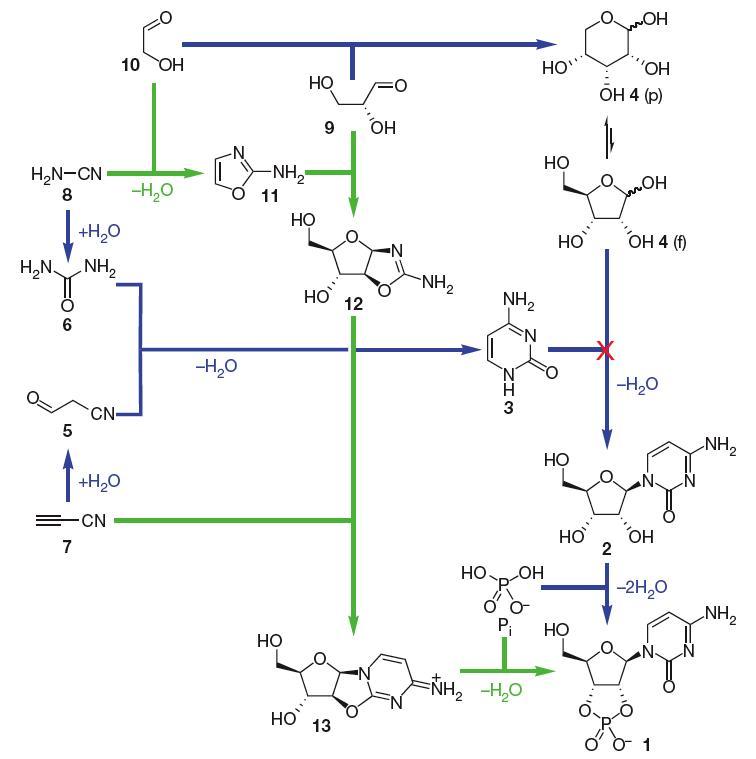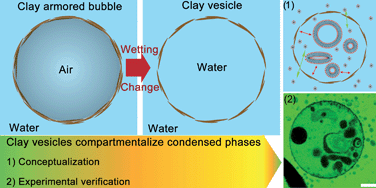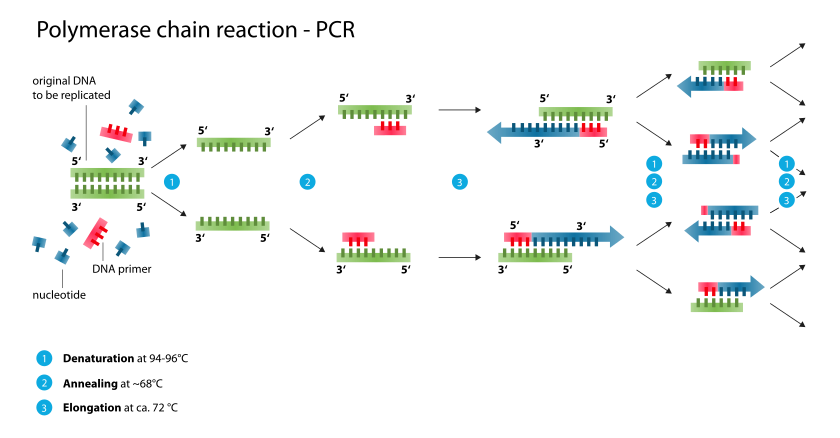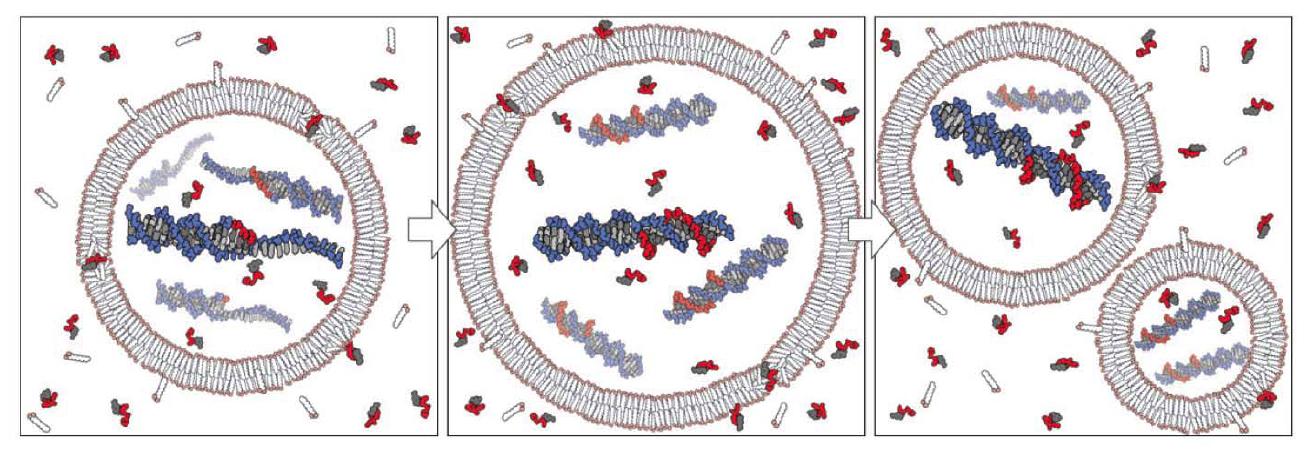OK, I think we're going to have to take a step back a bit here because it's clear from the passage above that you clearly don't understand what it is that is under discussion (particularly from your out of place reference to mutagenesis). So what I am going to do is go through step-by-step the mechanism by which genetic material can be formed from plausibe prebiotic compounds. I will, at each step, support my points (as usual) with reference to solid peer-reviewed science.
To begin I am going to briefly outline the steps in the sequence before going into more detail. The sequence that I am proposing is as follows:
1. A primordial earth with abundant hydrothermal activity, containing the following simple organic compounds: cyanamide, cyanoacetylene, glycolaldehyde, glyceraldehyde and also any inorganic phosphate.
2. The formation of activated ribonucleotides through a stepwise process to be detailed below.
3. Montmorillonite clay forms around an air bubble to create a semi-permeable cell wall.
4. Protected from the environment , ribonucleotides undergo polymerisation to form oligomers.
5. At the same time, the montmorillonite bubble acts as a catalyst by promoting the formation of a cell membrane from fatty acids.
6. As the clay cell floats about, shear and thermal stresses cause the clay to fracture releasing the protobiont into the surrounding ocean.
5. The presence of thermal vents on earth leads these protobionts to reproduce through a mechanism similar to the polymerase chain reaction.
6. Voila! Life
Step 1 - Formation of activated ribonucleotides
This step should be the easiest for you to follow because it only involves basic chemistry. The process progresses as follows:
1. Cyanamide and glycolaldehyde form a peptide bond to produce 2-amino-oxazole.
2. 2-amino-oxazole combines with glyceraldehyde to form a pentose amino-oxazoline.
3. Pentose amino-oxazolines combine with cyanoacetylene to form anhydroarabinonucleoside.
4. Anhydroarabinonucleoside undergoes (in the presence of an inorganic phosphate) phosphorylation to become B-ribocytidine-
2',3'-cyclic phosphate (an activated ribonucleotide).
Now before, we continue, here's a graphic illustrating the process and the science supporting it:

Synthesis of activated pyrimidine ribonucleotides in prebiotically plausible conditions
Step 2 - Vesicle formation
The next step is the formation a montmorillonite bubble to act as a temporary cell wall. In 2011 a team from Harvard, Princeton and Brandeis universities showed experimentally that a stable, semi-permeable vesicle can form from natural montmorillonite clay around air bubbles present in the ocean.

Semi-permeable vesicles composed of natural clay
This is an important development for three reasons:
1. The montmorillonite vesicle provides a stable compartment protecting anything in the interior from external reactions.
2. Montmorillonite catalyses the polymerisation of ribonucleotides to form RNA.
3. Montmorillonite catalyses the formation of fatty-acid vesicles leading to the development of a more stable and long-lasting cell wall inside the clay wall.
With regard to the first point, the study above shows the stability of the montmorillonite cells.
As for the second point, it has been demonstrated experimentally:
Oligomerization of ribonucleotides on montmorillonite: reaction of the 5'-phosphorimidazolide of adenosine
that montmorillonite catalyses the formation of oligomers from the activated ribonucleotides which we have already demonstrated above. These oligomers can reach as much as 50-mer lengths

One-Step, Regioselective Synthesis of up to 50-mers of RNA Oligomers by Montmorillonite Catalysis
These ribonucleotides can permeate the vesicle but once formed are trapped within the protocell membrane.
As for the third point, it has also been shown experimentally that montmorillonite catalyses the formation of fatty-acid vesicles.
Mineral Surface Directed Membrane Assembly
Once fatty-acid vesicle is produced the growth of the vesicle is autocatalytic which has also been demonstrated experimentally:
Autopoietic Self-Reproduction of Fatty Acid Vesicles
Once this self-sustaining reaction has begun (sustained by the attraction of nearby lipids), the growing fatty acid vesicle begins to exert an outward pressure on the montmorillonite shell. From basic materials science we know that montmorillonite being a ceramic material has good strength when in compression (hence protection from external forces) but weak in tension. As a result the growing vesicle shatters the montmorillonite shell and the resulting protobiont is free to float in the primordial ocean. So now we have a protobiont consisting of a fatty acid membrane which is permeable to monomers and small molecules but impermeable to the oligomer now trapped within.
The next step in the process is the growth of the oligomer to form RNA and other more complex biological polymers.
The basic reaction sequence that is followed is similar to that used in polymerase chain reaction (PCR) testing.

Now, here's where it gets interesting. We have above a mechanism for a reaction by which the oligomer inside the protobiont can form larger and more complex structures. However, what we are currently missing is something to kickstart this reaction. This is where the conditions of the early earth. Given what we know from basic geology, physics and geography, it is likely that the early Earth was populated with a vast number of hydrothermal vents.
Firstly, it has been shown that the protobionts described above are thermally stable at temperatures of up to 100 degrees:
Thermostability of model protocell membranes
At these elevated tempeatures the strands of polymer begin to denature while being trapped inside the vesicle while the vesicle itself expands allowing more monomers to cross into the cell whereby the current carries the cell away to a lower temperature where the nucleotides acquired at high temperature can bond to the denatured polymer backbone allowing for growth of the RNA. It can also lead to copying of the RNA. This is an important development. As the RNA inside the vesicle grows/copies it increases the osmotic pressure inside the cell. This causes the vesicle to attract nearby lipids at an even greater rate thus creating a larger cell. As these membranes grow they develop a tubular branched shape which can be divided by external forces such as shear stresses from thermal differentials in the ocean. Here's a nice little graphic to demonstrate what I mean.

As the authors note in the paper above:
"The strands of encapsulated double-stranded DNA can be separated by denaturation at high temperature while being retained within vesicles, implying that strand separation in primitive protocells could have been mediated by thermal fluctuations without the loss of genetic material from the protocell. At elevated temperatures, complex charged molecules such as nucleotides cross fatty-acid-based membranes very rapidly, suggesting that high temperature excursions may have facilitated nutrient uptake before the evolution of advanced membrane transporters. The thermostability of these membranes is consistent with the spontaneous replication of encapsulated nucleic acids by the alternation of template-copying chemistry at low temperature with strand-separation and nutrient uptake at high temperature. "
So now we have a cell containing RNA which is capable of growth and reproduction using only basic chemistry and relying only on thermodynamics and physical forces. We have a primitive living organism.
I'm afraid I'm going to have to leave it there for now. Tomorrow I'll continue with the increase in complexity and the introduction of DNA as well as addressing the rest of your points. However, as we can see from above we have already gotten from a simple non-living primordial earth to a primitive cell capable of growth and reproduction with no need for chance or design.
I realise that this post may have been overly long and containing a lot of hard science and citations so for anyone interested I present a more graphical and simplified explanation of the mechanism detailed above:
One final note: You know when you really get down to it intelligent design isn't all that hard to understand and tear apart. It is, at its core, based on two principles: reassurance and doubt. These may seem like contradictory principles but only because one is involved in the conception of ID and the other in its propagation.
The first principle is reassurance. The concept of ID is quite simple, it provides a reassurance mechanism by explaining all the detailed natural processes above with one all sweeping cause an intelligent designer. Moreover this designer has created order, creating animals within distinct kinds. The thing is, we all know, that the overwhelming majority of ID supporters fall into an easily identifiable category, conservative Christians. Moreover, we also know that these people overwhelmingly tend also to be politically conservative. Now, here's where it gets interesting. In 2003 a group of researchers conducted a meta-analysis on 88 studies of political conservatism involving over 22,000 people. The analysis found that:
"A meta-analysis (88 samples, 12 countries, 22,818 cases) confirms that several psychological variables predict political conservatism: death anxiety (weighted mean r = .50); system instability (.47); dogmatism-intolerance of ambiguity (.34); openness to experience (-.32); uncertainty tolerance (-.27); needs for order, structure, and closure (.26); integrative complexity (-.20); fear of threat and loss (.18); and self-esteem (-.09). "
Pretty much everything on that list are things that ID offers in spades, reassurance about death (afterlife), order, uncertainty. For ID supporters and creationists, tackling the surface flaws of ID are not going to have impact because the story is so comforting. To really impact ID we have to undermine its foundation as we have done above.
The second principle above is doubt. In 1969, a now infamous and yet anonymous tobacco company executive penned a memo which has become titled "Manufacturing doubt". In it he says:
"Doubt is our product, since it is the best means of competing with the "body of fact" that exists in the minds of the general public. It is also the means of establishing the controversy."
Doubt is the product sold by the ID movement. Through their "Wedge" strategy and their "Teach the Controversy" strategy they attempt to sow doubt and create a space for ID to compete with evolution because it cannot compete on facts alone.
No comments:
Post a Comment